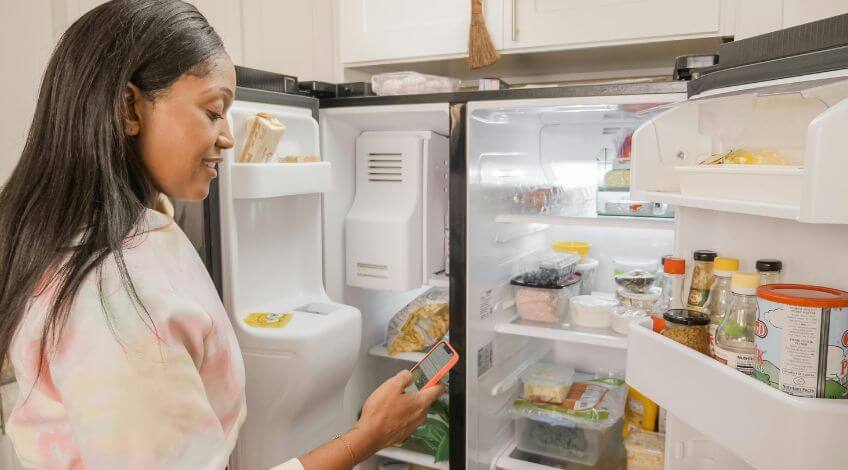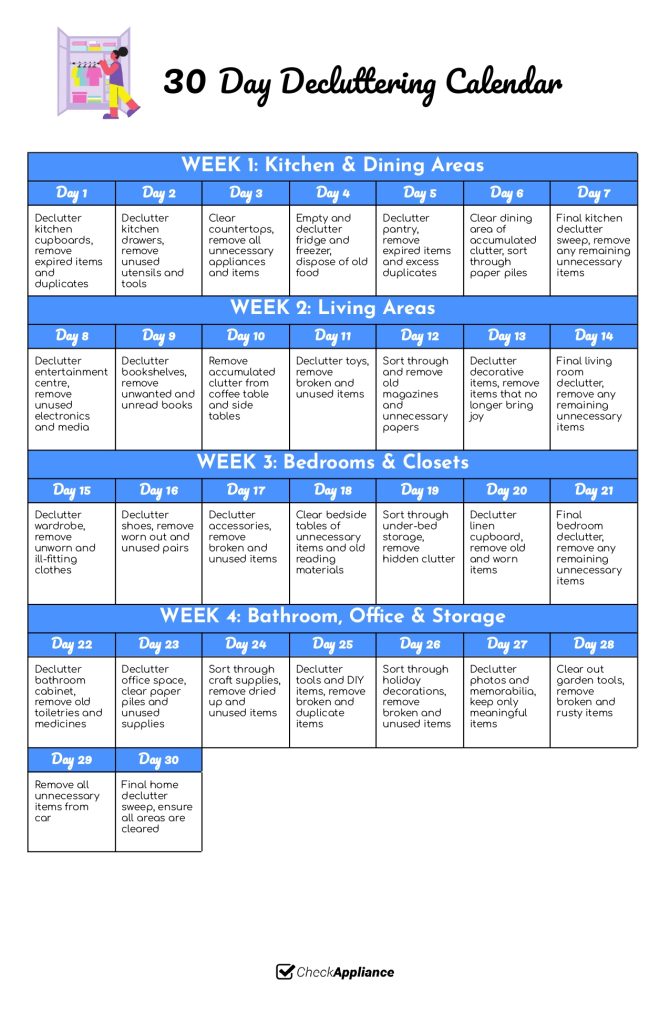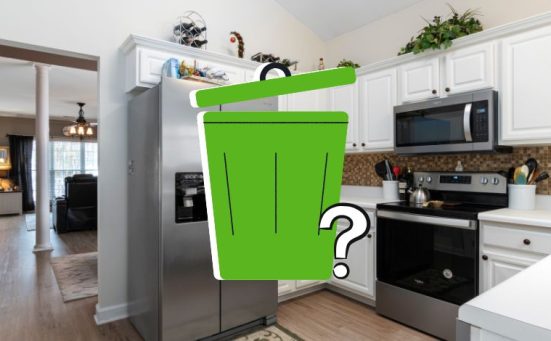
The 30-Day Decluttering Plan: A Clutter-Free Home in One Month!
Is your home feeling more like a storage unit than a living space?
Whether you are a busy professional drowning in paperwork, a parent managing endless toys, someone feeling overwhelmed by clutter, or going through a major life transition, this 30-day plan will transform your space from chaos to calm!
Let us break everything down into manageable daily tasks that work in real life, not just in those perfectly styled photos we see on social media. Plus, you will get a free decluttering calendar at the end to keep you on track!
Getting Started: Your Decluttering Kit
Before jumping in, let us get you set up for success. These tools will make your decluttering journey so much easier:
Essential Items
- Clear Storage Boxes: Perfect for organising and seeing what you have at a glance. Brilliant for busy professionals who need quick access to items
- Labels And A Marker: Trust me, you will thank yourself later when you are not playing the “what is in this box” game at midnight
- Donation Bags: Keep these handy for items that could find a better home. Essential for those in transition who are ready to let go
- A Timer: If you’re easily overwhelmed, a timer will be very helpful
Quick Clean Kit
Keep these nearby:
- Microfibre Cloths: Brilliant for quick dusting and wiping down surfaces
- All Purpose Cleaner: Choose something gentle enough for multiple surfaces
- Glass Cleaner: Perfect for mirrors and windows
- Bin Bags: For anything that needs to go straight in the rubbish
Week 1: Kitchen And Dining Areas
Start your decluttering journey in the heart of your home, where organisation can make the biggest impact on your daily life. From cupboards to countertops, we will transform your kitchen and dining spaces into efficient, clutter free zones that make cooking and gathering a joy.
Day 1: Kitchen Cupboards
Start with the heart of your home by tackling those kitchen cupboards.
Empty one cupboard at a time, working systematically through your space. This approach prevents you from feeling overwhelmed and lets you focus completely on each area before moving to the next.
Check expiry dates and duplicates as you sort through each cupboard. For busy parents, create easy to reach zones for kids’ snacks and dishes, placing them at child height to encourage independence. Consider using clear containers to make everything visible and installing shelf risers to maximise vertical space.
Day 2: Kitchen Drawers
Time to tackle those overflowing kitchen drawers that collect every gadget and utensil imaginable.
Sort through each drawer methodically, keeping only what you actually use in your weekly cooking routine. That third spatula or extra set of measuring spoons? If you have not used them in months, it is time to let them go.
Create designated spaces for everything using drawer dividers or small boxes. This system makes it easier to maintain order and quickly find what you need when cooking. Consider keeping frequently used items in the drawers closest to your primary work area for efficient meal preparation.
Day 3: Counter Space
Your kitchen counters are valuable real estate that often become cluttered with unnecessary items.
Start by removing everything from your counters completely, giving them a thorough clean. This reset helps you critically evaluate what truly needs to take up this valuable space.
Only return the items you use daily, such as your coffee maker or frequently used appliances. Everything else should find a home in your newly organised cupboards. Creating clear counters not only makes your kitchen look more spacious but also provides the workspace you need for efficient meal preparation.
Day 4: Fridge And Freezer
Today we will transform your fridge and freezer from chaotic to efficient.
Remove everything, checking expiry dates and tossing anything past its prime. Keep a cooler handy for items that need to stay cold while you work through this process.

Clean all shelves thoroughly and group items by category as you return them. Use clear containers to keep things visible and fresh, and implement zones for different food types. Consider creating an “eat soon” section in your fridge for items nearing their use by date, helping to reduce food waste and save money.
Day 5: Pantry Organisation
Transform your pantry into a system that makes cooking and shopping easier.
Start by grouping similar items together and checking expiry dates, being ruthless about disposing of anything past its prime. This initial sort helps you see what you actually have and prevents buying duplicates.
Invest in clear containers for bulk items like flour, sugar, and pasta, making sure to label everything clearly with contents and dates. Create zones based on how you cook, keeping baking items together, breakfast foods in one area, and dinner ingredients in another. Consider using shelf risers or lazy Susans to maximise space and make everything easily accessible.
Day 6: Dining Area
Your dining area should be a welcoming space for meals, not a dumping ground for daily clutter.
Start by clearing the table and surrounding area of anything that does not belong. This includes those piles of mail, work documents, and other items that tend to migrate here.
Create simple systems for managing paper flow, such as a small sorting station with folders for different types of mail and documents. Consider adding a designated spot for items that often end up here, like keys or children’s homework, making it easier to maintain order.
Day 7: Kitchen Deep Clean
Finish your kitchen week with a thorough deep clean of your newly organised space.
Start with the ceiling and work your way down, ensuring no surface is overlooked. This includes light fixtures, cabinet tops, and those often forgotten spaces behind appliances.
Pay special attention to high touch areas like handles, switches, and frequently used surfaces. A deep clean not only makes your space sparkle but also helps you maintain the systems you have put in place throughout the week.
Week 2: Living Areas
Time to tackle the spaces where you spend most of your waking hours. This week focuses on creating peaceful living areas that work for everyone in your household, from entertainment zones to toy storage solutions.
Day 8: Entertainment Centre
Today we tackle the entertainment area where electronics and media often create chaos.
Start by unplugging everything and sorting through your electronic items, testing each one to ensure it still works. Remove any outdated technology or media formats you no longer use or need.
Create a proper cable management system using ties or clips to prevent tangles. For parents, set up a gaming station that keeps consoles and accessories tidy but accessible. Consider digitizing your media collection to reduce physical clutter.
Day 9: Bookshelves
Time to transform your bookshelves from overwhelming to organised.
Take all books off the shelves and sort them into categories: keep, donate, and sell. Be honest about which books you will actually read again and which are just taking up space.
Create a logical organisation system that works for your family, whether by genre, colour, or size. Leave some empty space on each shelf for new additions and consider implementing a “one in, one out” rule to maintain order.
Day 10: Coffee Table And Side Tables
Focus on clearing and organising the surfaces that tend to collect daily clutter.
Remove everything from your coffee table and side tables, giving them a thorough clean. This reset helps you decide what truly deserves a place on these prominent surfaces.
Create designated spots for items you use regularly, such as remotes or coasters. Use decorative boxes or trays to corral necessary items while maintaining a stylish appearance.
Day 11: Toy Organisation
For families with children, today focuses on creating manageable toy storage systems.
Start by involving your children in the sorting process, making three piles: keep, donate, and repair. This teaches valuable lessons about organisation while ensuring you keep toys they actually play with.

Create clearly defined zones for different types of toys, using storage solutions that make cleanup easy for children. Consider implementing a rotation system, keeping some toys stored away to bring out later.
Day 12: Magazine And Paper Sort
Today we tackle the paper clutter that seems to multiply endlessly.
Gather all magazines, papers, and mail into one location. Sort everything into clear categories: action required, reference, and recycle. Create a simple filing system that can be maintained in just minutes each day.
Set up designated spots for incoming paper items and commit to processing them regularly. Consider scanning important documents and subscribing to digital versions of magazines to reduce future paper clutter.
Day 13: Decorative Items
Time to evaluate and organise your decorative pieces to enhance your space.
Review all your decorative items, keeping only pieces that truly reflect your current style and bring you joy. This is especially important for those in transition who are looking to refresh their space.
As you return items to their places, experiment with different arrangements. Group similar items together and vary heights for visual interest. Consider rotating seasonal decor to keep your space feeling fresh.
Day 14: Living Room Reset
Complete your living room transformation with a thorough reset of the entire space.
Move furniture slightly and vacuum thoroughly, including under and behind pieces that rarely get moved. Wipe down all surfaces and assess if your current arrangement best serves your family’s needs.
Create a quick evening reset routine to maintain your hard work. Take time to review all your new systems and make any necessary adjustments to ensure they work for your lifestyle.
Week 3: Bedrooms And Closets
Transform your bedrooms from cluttered messes to peaceful sanctuaries. This week we will tackle everything from overstuffed wardrobes to bedside tables, creating calm spaces that promote rest and relaxation.
Day 15: Wardrobe Sort
Begin the bedroom week by tackling your clothing collection.
Take everything out of your wardrobe and sort into clear categories: keep, donate, sell, and repair. Use the “if you have not worn it in a year” rule as a guide, being honest about what actually fits and suits your current lifestyle.
Create a system for the items you are keeping, grouping similar items together. This is especially important for busy professionals who need to quickly put together polished outfits each morning.
Day 16: Shoe Collection
Today focuses on organising your footwear into a manageable collection.
Remove all shoes from your wardrobe or storage areas and assess each pair honestly. Consider comfort, condition, and how often you actually wear them. Create separate spaces for seasonal footwear.
Clean the shoes you are keeping and invest in proper storage solutions to maintain their condition. Consider using clear boxes for special occasion shoes and creating an easily accessible system for everyday footwear.
Day 17: Accessories
Time to sort through your accessories and create better storage solutions.
Gather all accessories including jewellery, bags, belts, and scarves. Sort through each category, keeping only items you regularly use and love. Be realistic about what you actually wear versus what you are keeping out of guilt or habit.
Create dedicated storage spaces for each type of accessory, using drawer dividers, hooks, or specialised organisers. Make sure frequently used items are easily accessible while protecting special pieces.
Day 18: Bedside Tables
Transform your bedside tables into calm, clutter free spaces that promote better sleep.
Remove everything from your bedside tables and sort through the items. Keep only what you truly need within arm’s reach at night, such as a lamp, book, and perhaps a glass of water.
Create a charging station for necessary electronics that looks neat and organised. Consider adding small containers or drawers for items you want to keep nearby but out of sight.
Day 19: Under Bed Storage
Today we will tackle the often overlooked space under your bed.
Pull everything out from under your bed and sort through it thoroughly. This space should not become a catch all for items you are unsure about. Be selective about what deserves this prime storage space.
Use proper storage containers with lids to protect items from dust. This space is perfect for seasonal clothing, extra bedding, or rarely used items that you definitely want to keep.
Day 20: Linen Cupboard
Organise your linen cupboard to make bed changing and daily life easier.
Remove everything and sort through all bedding and towels. Check for wear and tear, donating or repurposing anything that is past its best. This is especially important for those in transition who want fresh starts.
Categorise items by type and size, using clear labels if needed. Consider storing sheet sets inside their matching pillowcase to keep everything together. Keep frequently used items at eye level.
Day 21: Bedroom Deep Clean
Complete your bedroom transformation with a thorough deep clean.
Start with the ceiling and work your way down, cleaning light fixtures, windows, and surfaces. Move furniture to clean underneath and consider if your current arrangement promotes good flow and restful sleep.

Pay special attention to areas that affect sleep quality, such as cleaning under the bed and vacuuming the mattress. Your bedroom should feel like a true sanctuary for rest.
Week 4: Bathroom, Office, And Storage Areas
Finish strong by organising the spaces that often collect the most clutter. From bathroom cabinets to home offices and those tricky storage areas, we will create systems that keep everything organised and accessible.
Day 22: Bathroom Cabinet
Begin your final week by organising the space where toiletries and medicines often expire unnoticed.
Start by removing everything from your bathroom cabinets and checking expiry dates on medicines and beauty products. Sort items into categories and be ruthless about disposing of old or unused products safely.
Create clearly labeled zones for different categories like first aid, daily toiletries, and medicines. Consider using drawer dividers or small bins to make everything easily accessible.
Day 23: Office Space
Transform your home office or work area into an efficient space.
Begin by sorting through all paperwork, creating clear filing systems that busy professionals can easily maintain. Separate documents into action required, reference, and archive categories.
Set up your desk with only essential items, creating homes for office supplies and technology. Consider implementing a digital filing system to reduce paper clutter going forward.
Day 24: Craft Supplies
Today focuses on decluttering your creative spaces and supplies.
Pull out all craft supplies and sort them by type. Be honest about projects you will actually complete and supplies you will use. This is especially important for parents managing children’s art supplies.
Create designated storage spaces for different types of supplies, making them easily accessible for projects. Consider creating activity boxes for children that can be easily taken out and packed away.
Day 25: Tools And DIY Items
Organise your tools and maintenance supplies into a functional system.
Gather all tools and DIY supplies into one location. Sort through everything, checking for duplicates and items that need repair or replacement.
Create a proper storage system using pegboards, toolboxes, or cabinets. Keep frequently used tools easily accessible and group similar items together.
Day 26: Holiday Decorations
Sort seasonal items to make decorating easier throughout the year.
Take out all holiday decorations and sort by season or holiday. Check for damaged items and either repair or dispose of them appropriately.
Pack decorations in clearly labeled, sturdy containers. Consider taking photos of your favourite holiday arrangements to make decorating easier next year.
Day 27: Photos And Memorabilia
Today we tackle those precious memories that deserve proper storage.
Sort through photos and keepsakes, deciding what truly deserves to be kept. This is especially important for those in transition who want to preserve memories while reducing physical clutter.

Consider digitizing photos where possible and create proper storage solutions for special items. Label everything clearly and store in appropriate conditions to preserve them.
Day 28: Garden Tools
Organise your outdoor items to make garden maintenance easier.
Sort through all garden tools and supplies, checking for items that need repair or replacement. Clean everything thoroughly before organising.
Create proper storage solutions that protect tools from weather and keep them easily accessible. Consider creating a garden maintenance station with frequently used items.
Day 29: Car Clean Out
Do not forget about your vehicle in this decluttering journey.
Remove everything from your car and sort items into keep, relocate, and dispose piles. Clean all surfaces thoroughly while the car is empty.
Create storage solutions for necessary items like emergency kits. Consider what you really need to keep in your car versus what can be stored elsewhere.
Day 30: Final Reset
Complete your decluttering journey with a final review of all spaces.
Walk through your home and check all the systems you have put in place over the past month. Make any necessary adjustments to ensure these systems work for your lifestyle.
Create a maintenance schedule for daily, weekly, and monthly tasks to keep your newly organised spaces functioning well. Celebrate your achievement and enjoy your clutter-free home!
Maintaining Your Clutter Free Home
Now that you have transformed your space, let us talk about keeping it that way!
Whether you are a busy professional, a parent managing a family home, or someone who has struggled with clutter in the past, these simple routines will help you maintain your newly organised space without feeling overwhelmed:
Daily Habits
Begin each day with small actions that prevent clutter from returning.
After a month of hard work, the last thing you want is to slip back into old habits. Start each morning by making your bed and ensuring everything is in its designated place.
Set aside 10 minutes each evening for a quick tidy up routine. Deal with mail as it arrives, put things away immediately after use, and do a quick surface clean before bed.
Weekly Tasks
Keep your momentum going with regular weekly maintenance.
Review any problem areas that tend to collect clutter, such as entryways, kitchen counters, or bathroom surfaces. Process any paper piles that have accumulated and do a quick declutter sweep of main living areas.
Take time to reset spaces to their original state. This might mean reorganising the pantry, straightening up closets, or tidying your office space.
Monthly Maintenance
Set aside time each month to review and refresh your systems.
Check storage systems to ensure they are still working effectively for your needs. Take note of any areas that might need adjusting and make changes before clutter can build up again.
Continue to donate unused items as you notice them, and review your systems regularly. A monthly deep clean of key areas helps maintain the fresh feeling you have worked so hard to achieve.
Why This Matters
A clutter free home is more than just a tidy space, it is a foundation for a calmer, more productive life. Whether you are juggling work and family life or simply seeking more peace in your daily routine, maintaining an organised home can transform how you live.
Here is why your efforts make such a difference:
Reduced Stress And Anxiety
Living in a clutter free environment has real benefits for your mental wellbeing.
Walking into an organised home immediately lowers stress levels and helps you relax. When everything has a place and systems run smoothly, you can focus on enjoying your space rather than feeling overwhelmed by it.
Improved Productivity
An organised home supports better time management and efficiency.
When you can find what you need quickly and systems work smoothly, you save countless hours previously spent searching for misplaced items. This efficiency carries over into all aspects of life, from getting ready in the morning to preparing meals.
Better Family Life
Decluttered spaces create calmer, happier family environments.
Children thrive in spaces where they can easily find their belongings and understand where things go. Family members are more likely to maintain tidy spaces when systems are clear and simple to follow.
More Time For What Matters
Less time spent managing clutter means more time for activities you enjoy.
Instead of spending weekends organising or searching for lost items, you can focus on quality time with family and friends.

DOWNLOAD YOUR FREE PRINTABLE 30-DAY DECLUTTERING CALENDAR HERE
Share these ideas with friends who could use some decluttering motivation, because everyone deserves a home that brings them joy!
SEE ALSO: 30 Day Deep Cleaning Challenge!
Also, follow us on Pinterest ...



